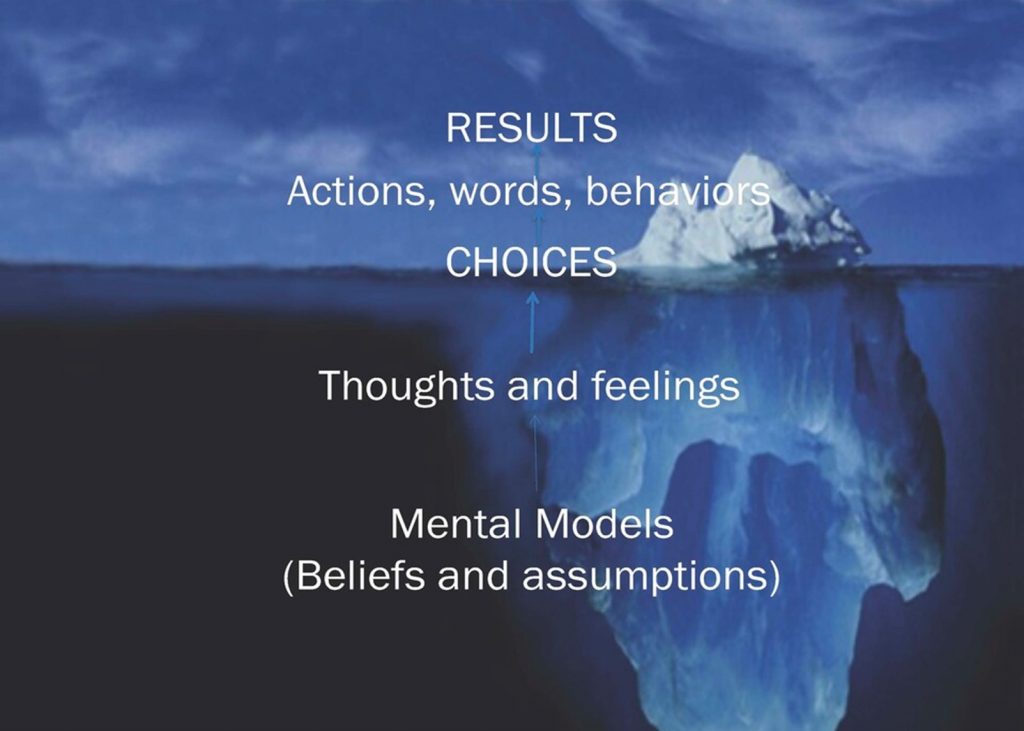
Are you getting the results you desire in your life (be it professional or personal)? Do you fully understand why you have (or haven’t) achieved them, or have you even considered it? The Iceberg Model could contain the answer.
As you consider the Iceberg Model, think about it regarding your own behaviors and choices, but also reflect on the subject regarding auditing, investigations, and interviewing. If you have been doing interviewing for any period of time, you know that a little bit is showing above the water, but there is so much more going on below the surface.
The Iceberg Model, also known as the Iceberg Theory or the Hidden Culture Model, is a concept that was introduced by psychologist Sigmund Freud and popularized by author Ernest Hemingway. It suggests that there are hidden, underlying layers of meaning and understanding beneath the surface of observable behaviors and events.
The Iceberg Model is based on the idea that only a small portion of an iceberg is visible above the water, while the vast majority remains hidden beneath the surface. Similarly, in human behavior and communication, there are conscious aspects that are readily apparent, but there are also deeper, unconscious elements that influence our thoughts, emotions, and actions. Is this not the essence of the interviewing journey.
The model is typically represented visually as an iceberg, with the visible portion above the water representing the conscious mind, and the submerged portion representing the unconscious mind. Here’s a breakdown of the different layers:
- Results/Choices – Conscious Mind: This is the visible part of the iceberg, representing the thoughts, feelings, and actions that we are aware of and can easily observe. It includes our rational thinking, logical reasoning, and intentional behaviors.
- Thoughts and Feelings – Preconscious Mind: This layer lies just below the surface and consists of information that is not currently in our conscious awareness but can be easily accessed. It includes memories, stored knowledge, and thoughts that we can readily bring to the conscious level with little effort.
- Mental Models – Unconscious Mind: This is the largest and deepest part of the iceberg, lying beneath the surface. It contains thoughts, desires, fears, and memories that are repressed or not readily accessible to our conscious awareness. The unconscious mind influences our behavior, motivations, and emotions, often without our conscious understanding.

The Iceberg Model suggests that much of our behavior and the true meaning behind it is driven by unconscious factors. It implies that there may be hidden motivations, conflicts, or unresolved issues that impact our perceptions and actions, even if we are not consciously aware of them. Exploring and understanding the deeper layers of the iceberg can provide insight into our behavior and promote self-awareness and personal growth.
The Iceberg Model is a framework to better understand ourselves and how the choices we’ve made have led to the results we’ve obtained. It provides that connection between what we do is and its relationship to what we’ve chosen. Most of the time circumstances and chance don’t have all that much to do it. At the top of the iceberg, we see actions and results. These are above the water level, the smallest portion of the iceberg. They are visible to us as well as others. Immediately at the water level, sometimes visible and sometimes not, are our choices.
Choices are driven by how we have framed the situation (our thoughts, feelings, and mental models) and are all below the water level. Thoughts and feelings are self-evident. Mental models, as we have discussed before, are the images, assumptions, and stories which we carry about ourselves, other people, institutions, and every aspect of the world– like a pane of glass framing and sometimes subtly distorting our vision. These are the frequent basis of the biases that can often negatively affect or interviewing performance. Mental models determine what we see, and these historically existing biases are a particularly destructive type of mental model.
To learn how to increase the likelihood of good outcomes and lessen bad ones, we must become aware of the thoughts and feelings influencing our choices. Those are most likely, in turn, being influenced by our mental models which often need examining. The deepest and most lasting change occurs only when we identify and address what is going on below the water level, though action can be taken at any level. We can help ourselves and each other change by examining every layer of the iceberg and challenging ourselves and others to drop deeper and deeper.
It takes discipline and perseverance to drop the water level and become more aware of what is going on underneath. In expanding our awareness, we increase our capacity to recognize our choices and make new ones, which results in different outcomes.
Here are some tips for dropping the water level:
- Find a good friend/accountability partner that can objectively help you to see more clearly what is going on.
- If you are a leader/manager and see coaching as at least part of your job, try leading someone using the model—using it in this way might also make it easier for you to do this for yourself. As they say, if you want to learn a subject, teach it. There is no better way to learn it.
- Keep a journal in which you capture outcomes (of both types, the good and the bad). Even if you don’t have time to capture anything other than the choices that led to the outcomes, you might start to see a pattern in your choices that motivates you to learn more about what is driving those choices that lie deeper under the water. Be introspective.
Anderson Investigative Associates is positioned to custom-tailor training to your specific needs. If you have any questions or would like to discuss the above topic of the Iceberg Model, please reach out. Additional issues pertaining to interviewing, auditing, and investigations can be found in other blogs and videos that we have produced and are contained in most blocks of instruction that our company presents.
If you have additional questions, comments, or have an interviewing topic you would like me to address, give me a shout. In the meantime, be well, stay safe out there, and explore that level of mental modes to ultimately address behaviors….it will raise contentment and performance.
Mark A. Anderson
Director of Training and Development
Anderson Investigative Associates, llc
114 Loucks Avenue
Scottdale, PA 15683
manderson@andersoninvestigative.com
tel:912-571-6686
